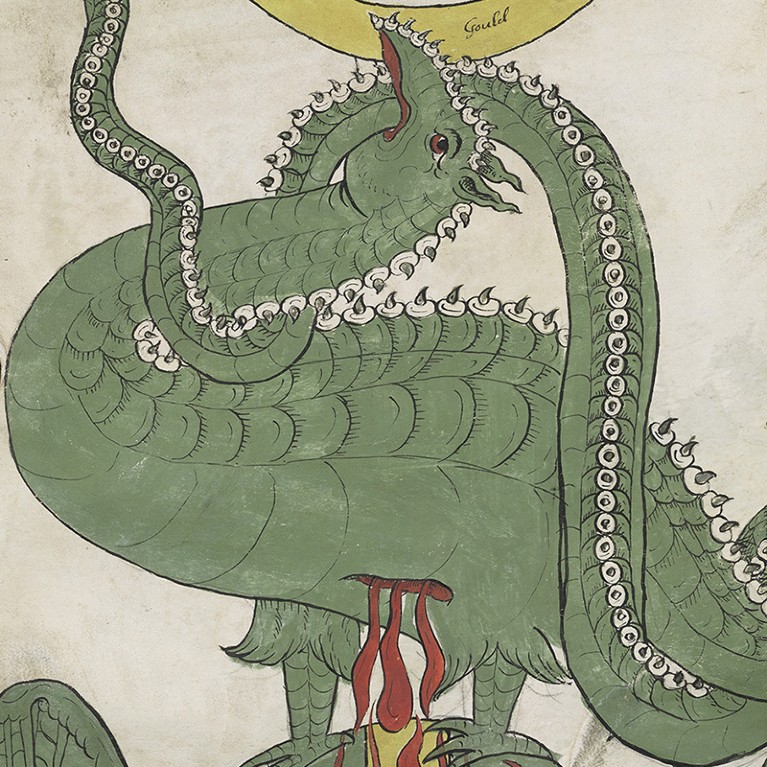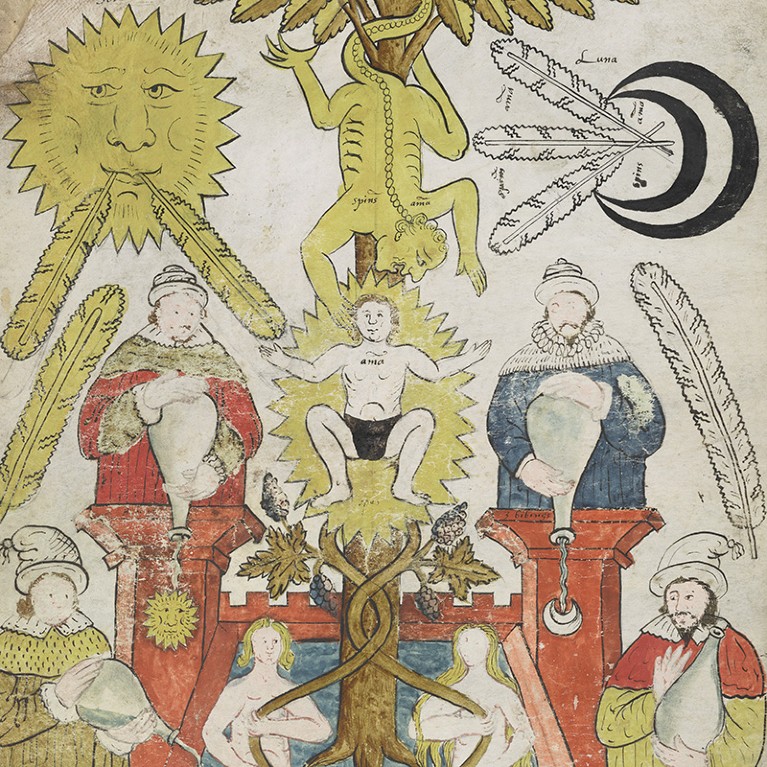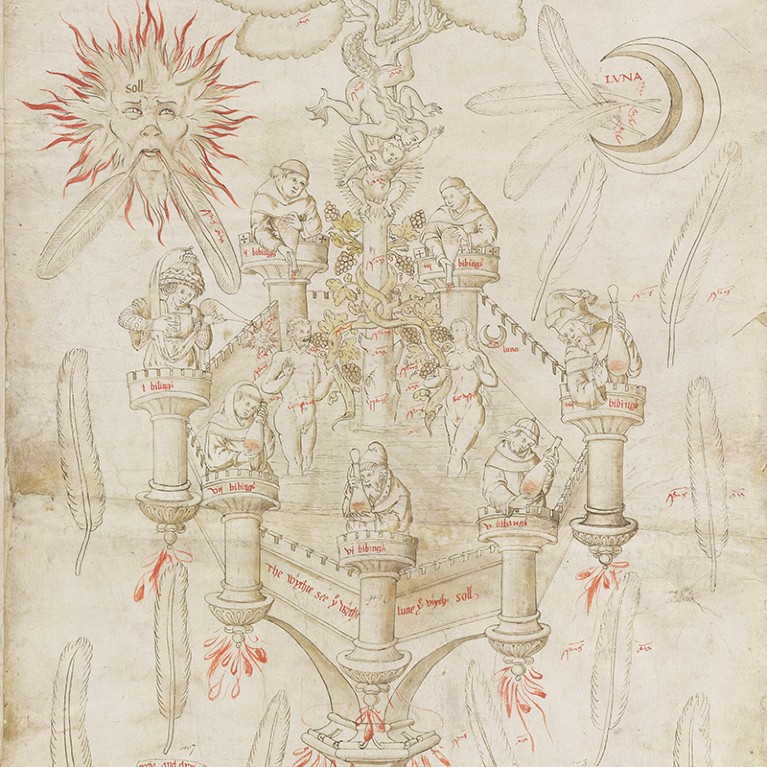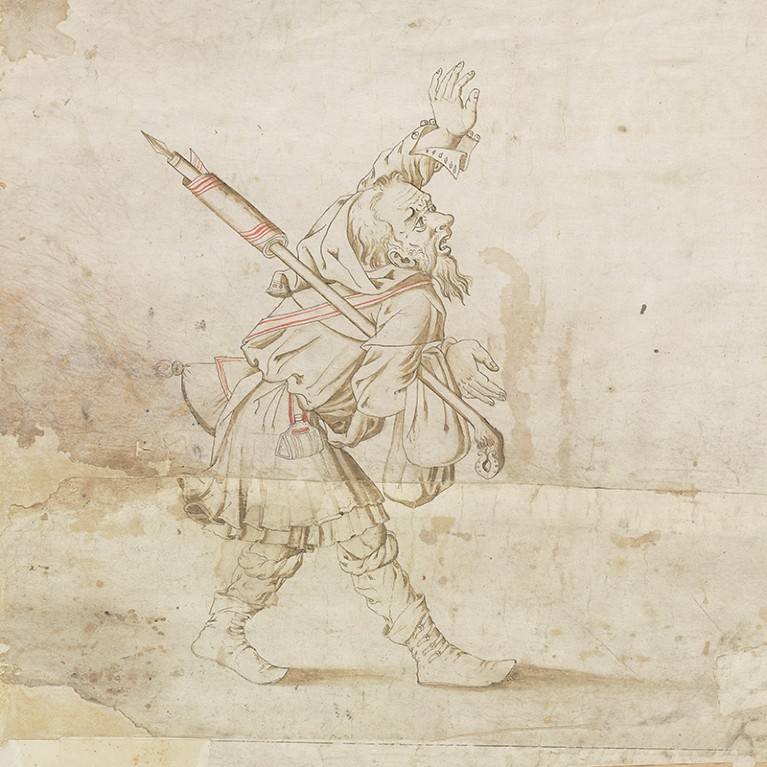
The ‘Serpent of Arabia’, philosophical mercury, dissolves gold and silver to create an elixir — its own life-giving blood.Credit: Leonard Smethley MS. Roll/Princeton University Library
Painted on a seventeenth-century parchment roll, a human-headed eagle devours its own wings. This bizarre figure is not the product of myth or divine revelation, but of chemistry — visual shorthand for the solidification of a once-volatile substance as it loses its ability to ‘fly’.
The manuscript in which it appears, one of the Ripley Scrolls, is the centrepiece of an exhibition on alchemical imagery. Originally scheduled to open this month at Princeton University Library in New Jersey, it is now postponed until April 2021 in light of the current pandemic. As curator of the exhibition, and author of a related book out this year, I am vividly reminded of the economic and medical upheavals that alchemy was once intended to combat.
Fifteenth-century Europe ran low on bullion, partly owing to balance-of-payments deficits with Asia and the Middle East, sharpened by the local effects of war, famine and plague. Alchemists sought to resolve the shortage by transmuting base metals into gold and silver. To counter plague, they pursued medicinal elixirs. Their methods, disguised behind allegorical language and obscure, fantastical imagery, seem disconnected from those of modern science and medicine. Yet their images reveal a deep concern with understanding and capturing the dynamic nature of matter — a goal that still resonates and fascinates.
Philosophers’ stone
The Ripley Scrolls rank among the most spectacular products of the alchemists’ tradition. The oldest surviving example was produced in England in the late fifteenth century, although its exact provenance is unknown. The design was repeatedly copied, and now survives in one codex, or book, and 22 parchment and paper rolls, ranging from one to 7 metres long. Each is embellished with vibrant figures and verses, which set out the process for making the philosophers’ stone and the elixir of life.
Ripley Scrolls were collected and studied by some of the most influential figures in English alchemy, including the Elizabethan astrologer and mathematician John Dee and the natural philosopher Isaac Newton, who made detailed notes on their design. In the seventeenth century, Elias Ashmole, a founding member of the Royal Society, owned five of the rolls and attributed the original to George Ripley, a canon from Yorkshire, who was famous for his 1471 poem The Compound of Alchemy.

A toad (prime matter) putrefies in the vessel, and further steps are presented in miniature form.Credit: Leonard Smethley MS. Roll/Princeton University Library
Ripley might not actually have designed the original Scroll himself, but the images still shed light on how he and his contemporaries viewed matter and chemical change. The design opens with the figure of a philosopher holding a large glass vessel. Inside it, the first steps of his work are depicted in miniature allegorical scenes — incomprehensible to uninformed viewers, but packed with meaning for those in the know. The first shows a man and woman being attacked by humans and animals including a lion and a toad, signifying the ‘death’ (or dissolution) of metallic bodies.
More than 2,000 years of elements: a prehistory of the periodic table
The complexities of alchemical imagery echo a deep problem for medieval natural philosophers: how to visualize the inner structures and workings of matter. Unlike models of the cosmos or natural-history specimens, medieval theories of matter did not lend themselves easily to either diagrammatical or naturalistic representation. Substances change state during chemical operations, losing one form while mysteriously acquiring another. Such dynamic processes, involving change at a level that cannot be grasped by the senses, are almost impossible to describe in a way that accurately conveys either matter’s profundity or the minute incremental shifts through which it alters. The problem persists today, as evinced by modern attempts to represent the interior of the atom, or to model the structures of complex molecules.
For alchemical image-makers, one solution was to invoke analogies with other dynamic aspects of creation, from human reproduction to the motion of heavenly bodies. Byzantine Greek texts described ingredients and processes using metaphorical language (mercury could be ‘dew’ or ‘seed of the dragon’) that later offered rich resources for illustration. As medieval Muslim and Christian alchemists adopted this language, their imagery grew more sophisticated, developing major tropes such as the ‘chemical wedding’ of Sun and Moon — variously interpreted as sulfur and mercury or gold and silver.

A child is born from the chemical wedding of Sun and Moon, drawn out by the philosophical mercury.Credit: Leonard Smethley MS. Roll/Princeton University Library
Medieval writers did not assume that matter was made of particles. Europeans adopted an idea from Islamic alchemy, which saw metals in terms of two primordial constituents: hot, dry ‘sulfur’ and cool, running ‘mercury’ (principles that do not always correspond to the elements that share those names). At the same time, both Islamic and Christian philosophers followed Aristotle in defining substances according to bundles of properties: hardness, yellowness and heaviness, for instance, in the case of gold. Aristotle suggested that these attributes were carried by an underlying ‘prime matter’ that had no form of its own and existed in a potential, indiscernible state.
Allegorical dragons
The representation of properties, rather than structures, became a major feature of European alchemical imagery. In the fifteenth century, alchemists developed elaborate sequences of allegorical illustrations that allowed informed readers to decipher basic processes. Fixed, solid matter might be signified by an earthbound toad, or a volatile substance by a bird or feathers. A solvent could be a voracious lion or wolf.
Above all, alchemists strove to capture the fluid, penetrative properties of ‘mercury’. The term described not just metallic quicksilver, but other products, including philosophical mercury — a solvent made from quicksilver. In several fifteenth-century illustrations, mercury is shown as a hybrid creature, half-human and half-serpent: a visual reference to its dual state as ‘body’ (used to denote metals) and ‘spirit’ (volatile substances). In the Ripley Scrolls, philosophical mercury is variously depicted as a dragon eating a red toad (perhaps representing the dissolution of red lead) and as a snake-tailed woman in a tree. The latter is set in an alchemical rendering of the Garden of Eden, in which the mercurial serpent extracts the souls of Adam and Eve (gold and silver). Many of these images can be tied to specific processes, such as the production of a medicinal elixir based on lead compounds and distilled vinegar, popularized by Ripley.

The chemical wedding reinvented as the Fall of Man.Credit: Princeton MS. 93/Princeton University Library
Royal patronage
The Scroll was probably created as a gift to solicit patronage. The final section shows a plainly dressed figure — the author of the original — clasping a pilgrim’s staff topped with a pen nib. In some versions, he faces a king, possibly the intended recipient. Henry IV made alchemy illegal in England in 1403–04 (reflecting concern over counterfeit coinage) but English monarchs could still permit individual alchemists to practise. My forthcoming book, The Experimental Fire, traces how rulers including Henry VI, Edward IV, Henry VIII and Elizabeth I issued licences or sponsored alchemical projects — including the production of multipurpose elixirs for transmutation and healing.
Although the basics of alchemical imagery remained consistent over centuries, the underlying chemistry inevitably changed. One consequence was a loss of meaning over time, as figures acquired generic identities. By 1720, proponents of the new discipline of chemistry had adopted their own forms of nomenclature and representation.

The author is depicted at the end of the scroll in the guise of a pilgrim.Credit: Princeton MS. 93/Princeton University Library
Alchemical images are now completely uncoupled from mainstream scientific practice. Nevertheless, they capture the colour and dynamism of chemical transformations in ways seldom achieved by their more respectable textbook cousins.
The Ripley Scrolls continue to attract attention when displayed, including at the British Library’s wildly successful exhibition Harry Potter: A History of Magic, in 2017–18. In December 2017, the last Scroll in private hands was purchased in London by Princeton University for more than £500,000 (US$620,000). I hope that it will finally go on display next April, alongside an earlier copy, at Princeton’s exhibition Through a Glass Darkly: Alchemy and the Ripley Scrolls. Their chemistry might have transmuted, but the legacy of the alchemical philosophers is still being unrolled.

 More than 2,000 years of elements: a prehistory of the periodic table
More than 2,000 years of elements: a prehistory of the periodic table
 In retrospect: A New System of Chemical Philosophy
In retrospect: A New System of Chemical Philosophy
 In retrospect: The Sceptical Chymist
In retrospect: The Sceptical Chymist
 History: Realms of gold
History: Realms of gold
 Women at the edge of science
Women at the edge of science








